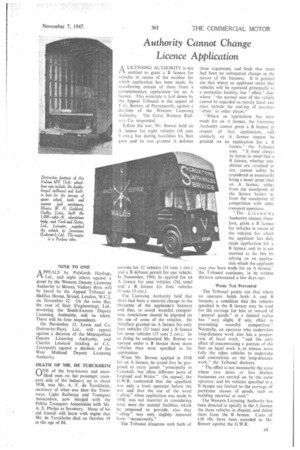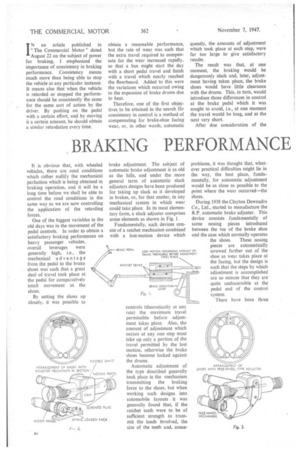Authority Cannot Change
Page 35

Page 36

If you've noticed an error in this article please click here to report it so we can fix it.
Licence Application
NINE TO ONE
A PPEALS by Pulsfords Haulage, 1-%. Ltd., and eight others against a grant by the Western Deputy Licensing Authority to Messrs. Vickery Bros. will be heard by the Appeal Tribunal at Halifax House, Strand, London, W.C.2, on November 12. On the same day, the case of Stair. (Engineering), Ltd., involving the South-Eastern Deputy Licensing Authorfty, will be taken. There will be four respondents.
On November 13, Lewis and Co. (Sutton-by-Pass), Ltd., will appeal against a ckcision of the Metropolitan Deputy Licensing Authority, and Charles Leonard (trading as C.L. Transport) against a decision of the West Midland Deputy Licensing Authority.
DEATH OF 114R. DE TURCKHEIM ()NB of the best-known and mostIs" liked men on _the passenger transport side of the industry up to about 1938, was Mr. A. F. de Turckheim, secretary of what was then the Tramways, Light Railways and Transport Association, now merged with the PUblic Transport Association with Mr. A. E. Phelps ai Secretary. Many of his Old friends will learn with regret that Mr. de Turckheim died on October 19 at the age of 84.
A LICENSING AUTHORITY is not PAentitled to grant a B licence for vehicles in excess of the number for whiCh application has been made, by transferring certain of them from a complementary application for an A licence. This principle is laid down by the Appeal Tribunal in the appeal of T. G. Brewer, of Perranporth, against a decision of the Western Licensing Authority, The Great Western Railway Co. responded.
Before the war, Mr. Brewer held an A licence for eight vehicles (18 tons 9 cwt.), but during hostilities his fleet grew and he was granted A defence permits for 12 vehicles (34 tons 1 cwt.) and a B defence permit for one vehicle. In November, 1946, he applied for an A licence for nine Vehicles (261 tons) and a B licence for four vehicles (9 tons 13 cwt.).
The Licensing Authority held that there had been a material change in the character of the applicant's business and that, to avoid wasteful competition. restrictions should be imposed on the use of some of the vehicles. He therefore granted an A licence for only four vehicles (I3 tons) and a B licence for seven vehicles (17 tons 2 cwt.). In so doing he authorized Mr. Brewer to operate under a B licence three more vehicles than were specified in his application.
When Mr. Brewer applied in 1938 for art A licence, he stated that he proposed to carry goods "principally in Cornwall, but often different parts of England and Wales." On appeal, the G.W.R. contended that the appellant was only a local operator before the war and that the use of the word
often," when application was made. in 1938, was not material in considering what Were the normal facilities which he proposed to provide, also that "often" was only slightly removed from " occasionally."
The Tribunal disagrees with both of these arguments, and finds that there had been no substantial change in the nature of the business. It is pointed out that where an applicant states that vehicles will be operated principally in a particular locality, but " often " elsewhere, "the normal user of the vehicle cannot be regarded as merely local, and must include the making of journeys ' often' to other places."
"Where an application has been made for an A licence, the Licensing Authority cannot grant a B licence in respect of that application, arid similarly an A licence cannot be granted -on an application for a B licence," the Tribunal says. " it must always be borne in mind that a B licence, whether conditions are attached or not, cannot safely be considered as necessarily being a lesser grant than an A licence, either from the standpoint of the licence holder or from the standpoint of ccinipetition with other transport operators. .
"The Licensing Authority cannot, therefore, grant a 13. licence for vehicles in excess of the vehicles for which the applicant has duly made application for a B licence, and he is not enabled to do this by retying on an application which the applicant may also have made for an A licence:. the Tribimai continues, in its written decision announced a few days ago.
Waste Not Prevented The Tribunal points out that where an operator holds both A and B licences, a condition that the vehicles specified in the B licence may be used for the carriage for hire or reward of "general goods" in a limited radius has "very slight, if any, effect in preventing wasteful competition." Normally, an operator who undertakes long-distance work also has a proportion of focal work, "and the only effect of concentrating a portion of the fleet on local work is to release more fully the other vehicles to undertake and concentrate on the long-distance work," the Tribunal declares.
"The effect is not necessarily the same where two more or less distinct businesses are carried on by the same operator, and his vehicles specified in a B licence are limited to the carriage of particular classes of goods, such as building material or coat."
The Western Licensing Authority has been directed to specify in the A licence the three vehicles in dispute, and delete them from the B licence. Costs of £10 10s. have been awarded to Mr. Brewer against the G.W.R.
IN an article published in "The Commercial Motor" dated August 22 on the subject of power for braking, I emphasized the importance of consistency in braking performance. Consistency means much more than being able to stop the vehicle at any particular instance. It means also that when the vehicle is retarded or stopped the performance should be consistently the same for the same sort of action by the driver. By pushing on the pedal with a certain effort, and by moving it a certain amount, he should obtain a similar retardation every time.
obtain a reasonable performance, but the rate of wear was such that the extra travel required to compensate for the wear increased rapidly, so that a bus might start the day with a short pedal travel and finish with a travel which nearly reached the floorboard. Added to this were the variations which occurred owing to the expansion of brake drums due to heat.
Therefore, one of the first objectives to be attained in the search thr consistency in control is a method of compensating for brake-shoe facing wear, or, in other words, automatic quently, the amounts of adjustment which took place at each step, were far too large to give satisfactory results.
The result was that, at one moment, the braking would be dangerously slack and, later, adjustment having taken place, the brake shoes would have little clearance with the drums. This, in turn, would introduce those differences in control at the brake pedal which it was sought to avoid, i.e., at one moment the travel would be long, and at the next very short.
After due consideration of the




















































































